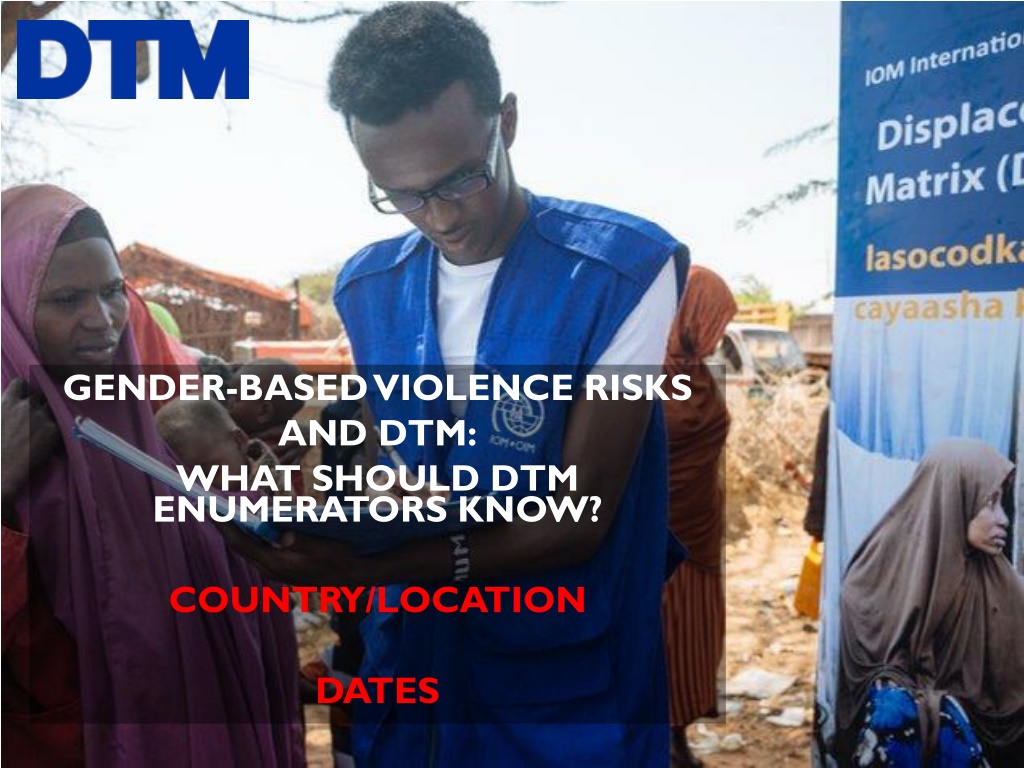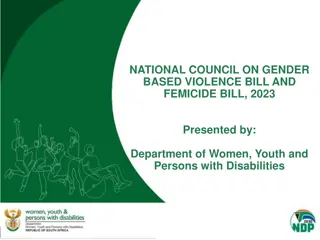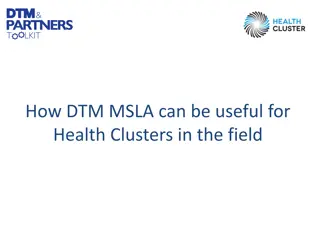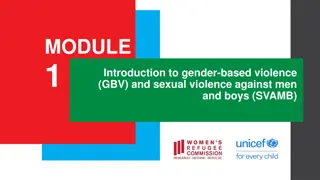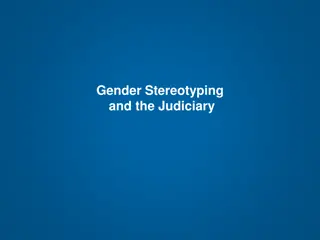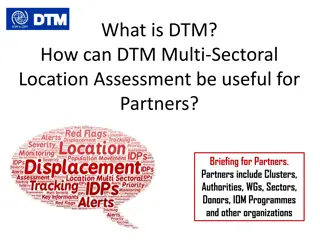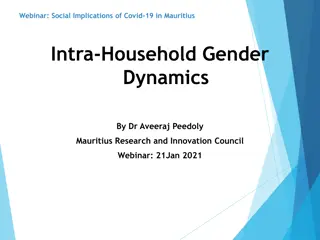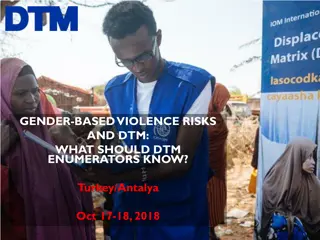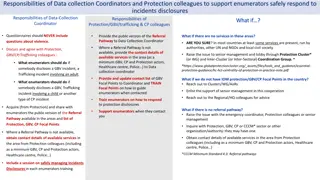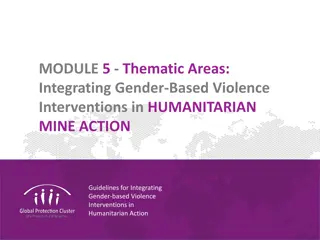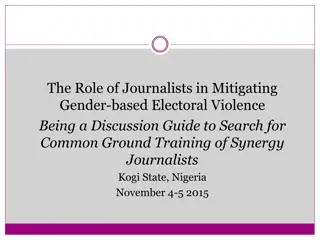Understanding Gender-Based Violence Risks and DTM Enumerators' Responsibilities
This content focuses on educating enumerators about gender-based violence (GBV) risks and Differential Timing Methodology (DTM). It covers learning objectives such as differentiating between sex and gender, defining GBV, identifying forms of GBV, understanding its root causes, and exploring how emergencies can exacerbate GBV risks. Activities include group exercises to identify traits associated with men and women. The content also discusses the differences between sex and gender, various forms of GBV beyond rape, and the concept of GBV as any harmful act based on gender differences. Enumerators are encouraged to explore root causes and risk factors for GBV in their specific contexts.
Download Presentation

Please find below an Image/Link to download the presentation.
The content on the website is provided AS IS for your information and personal use only. It may not be sold, licensed, or shared on other websites without obtaining consent from the author. Download presentation by click this link. If you encounter any issues during the download, it is possible that the publisher has removed the file from their server.
E N D
Presentation Transcript
GENDER-BASED VIOLENCE RISKS AND DTM: WHAT SHOULD DTM ENUMERATORS KNOW? COUNTRY/LOCATION DATES
Part 1 GENDER BASED VIOLENCE AND DTM
Learning objectives 1. Be able to differentiate between Sex and Gender 2. Define GBV 3. Identify forms of GBV, root causes, contributing factors and consequences of GBV 4. Understand how emergencies can exacerbate GBV risks GENDER BASED VIOLENCE AND DTM
Activity Divide into 2 groups In a flip chart Group one: Identify personality traits, attributes, and roles that are often associated with women. Group two: Identify personality traits, attributes, and roles that are often associated with men GENDER BASED VIOLENCE AND DTM
Sex vs. Gender Sex Gender Physical/ biological differences between females and males Social differences between males and females Determined by biology Determined by social factors history, culture, tradition, societal norms, religion Does not change (without surgical intervention) Involves the socialization for boys and girls, and men and women and can change over time. GENDER BASED VIOLENCE AND DTM
GBV = rape, right? Rape is a form of GBV but so are: Sexual violence that does not end up in rape Domestic violence/Intimate Partner Violence Harmful traditional practices Forced/early/child marriage Denial of resources or opportunities Sexual harassment Sexual exploitation Sex-selective abortion Some forms of trafficking etc . GENDER BASED VIOLENCE AND DTM
Gender-Based Violence (GBV) Gender-based Violence (GBV) is an umbrella term for any harmful act that is perpetrated against a person s will and that is based on socially ascribed (i.e. gender) differences between males and females. It includes acts that inflict physical, sexual or mental harm or suffering, threats of such acts, coercion, and other deprivations of liberty. These acts can occur in public or in private. GENDER BASED VIOLENCE AND DTM
Understanding GBV- Exercise In small groups, identify: Root causes for GBV Specific risk factors for GBV in your context? - What increases the likelihood of GBV occurring? Consequences of different forms of GBV? - Physical, social, economic, psychological? GENDER BASED VIOLENCE AND DTM
Consequences of GBV Forms of GBV Root causes and contributing factors GENDER BASED VIOLENCE AND DTM
Root causes and contributing factors of GBV GENDER BASED VIOLENCE AND DTM
Consequences of GBV GENDER BASED VIOLENCE AND DTM
Why does GBV occur in emergencies? Pre-existing - exists independent of, or prior to emergency or conflict Emergency-related - specific to/resulting from the disaster or conflict Humanitarian-related - caused directly or indirectly by humanitarian environment GENDER BASED VIOLENCE AND DTM
How is GBV exacerbated in emergencies? New threats/forms of GBV related to conflict Lack of privacy; overcrowding; lack of safe access to basic needs Design of humanitarian aid heightens or introduces new GBV risks Separation from family members; lack of documentation; registration discrimination Breakdown of protective social mechanisms and norms regulating behaviour Increased vulnerability and dependence; exploitation Introduction of new power dynamics, as with humanitarian actors GENDER BASED VIOLENCE AND DTM
Can GBV happen to men and boys? Gendered vulnerabilities can put ANYONE - men, women, boys and girls - at heightened risk for violence but not all violence is gender-based. In those cases where men and boys are exposed to GBV humanitarians must ensure care and support for all survivors. The contexts, causes, and consequences of violence against women and girls/men and boys are different. Risk analyses that take gender into account are critical to inform programming. GENDER BASED VIOLENCE AND DTM
Summary of GBV Part 1 GBV is rooted in gender and power inequalities that exist outside of conflict or disaster but that can be exacerbated by it. Additionally, there are particular ways that GBV can manifest in an emergency context. Always assume that GBV is occurring. Obtaining prevalence data or evidence is NOT advisable and NOT our rolein an emergency. Because ofunder-reporting and therisks associated with obtainingdata, the priority is to establish prevention, mitigationand response measures as soon as possible. GENDER BASED VIOLENCE AND DTM
Part 2 GENDER BASED VIOLENCE AND DTM
Learning objectives Understand the role of non-GBV specialists in GBV prevention, mitigation and response Learn how to mainstream GBV in the DTM Become familiar with GBV related indicators and their definitions Know how to safely and ethically respond to a GBV disclosure and become familiar with the referral mechanisms GENDER BASED VIOLENCE AND DTM
Roles and responsibilities towards GBV SPECIALIZED PROGRAMMING: specialists Direct service delivery GBV MAINSTREAMING all actors Avoid creating or exacerbating risks of GBV Reduce existing risks Understand and link to referral mechanisms for GBV survivors Applying core minimum standards into agency activities Case management GBV specialized psychosocial support Clinical care Legal support Economic reintegration How to mainstream GBV in the DTM? GENDER BASED VIOLENCE AND DTM
What a DTM enumerator should do to mainstream GBV Avoid creating or exacerbating risks of GBV. Identifying risk factors and trends (through indicators provided). Inform yourself about services available and on what you should you come across a GBV survivor, know the referral mechanisms in place and comply with standards set in guidelines. GENDER BASED VIOLENCE AND DTM
1/ Avoid creating or exacerbating risks of GBV IOM Standards of Conduct Prevention of Sexual Exploitation and Abuse (PSEA) by aid workers Do no harm GENDER BASED VIOLENCE AND DTM
2/ Identifying risk factors and trends through the indicators provided Before starting: methodologies Choice of key informants Focus group discussions Importance of gender-balanced teams Importance of choosing the place and the time for DTM assessments GENDER BASED VIOLENCE AND DTM
The importance of SADD Sex and Age Disaggregated Data (SADD) are important for all responders, including GBV actors Why collecting SADD? What can SADD tell us? Why SADD are important for humanitarian actors including GBV specialists? GENDER BASED VIOLENCE AND DTM
Indicators and definitions The cards game Divide into 4 groups Match the term/word with the correct definition GENDER BASED VIOLENCE AND DTM
Indicators and definitions The Site Assessment form With your neighbour: Go through the site assessment form Identify all the indicators in the form that could help specialized actors to identify risks of GBV Debriefing will take place in plenary GENDER BASED VIOLENCE AND DTM
3/ Responding to a GBV disclosure as a non-GBV specialist DTM enumerators should not look for individual incidents or number of GBV cases However, in some cases it may happen that a GBV incident is disclosed to you Anyone the survivor tells about his/her experience has a responsibility to give honest and complete information about services available. How to respectfully and supportively engage with survivors and provide referral information in an ethical, safe and confidential manner? GENDER BASED VIOLENCE AND DTM
The survivor-centered approach GENDER BASED VIOLENCE AND DTM
A Survivor-Centered response Key Principles: Safety, Confidentiality, Non-discrimination, Respect The survivor should tell the story once, hopefully to a specialist DO NO HARM Informed consent Access to specialized services GENDER BASED VIOLENCE AND DTM
What are referrals? The processes by which a survivor gets in touch with professionals and/or institutions regarding his/her case AND The processes by which different professional sectors communicate and work together, in a safe, ethical and confidential manner, to provide the survivor with comprehensive support GENDER BASED VIOLENCE AND DTM
What is a referral pathway? A flexible mechanism that safely links survivors to supportive and competent services Can include any or all of the following: Health, Psychosocial, Security and Protection, Legal/Justice, and/or Economic Reintegration support GENDER BASED VIOLENCE AND DTM
Example of referral pathways GENDER BASED VIOLENCE AND DTM
In your mission/duty station: GENDER BASED VIOLENCE AND DTM
Part 3 GENDER BASED VIOLENCE AND DTM
Scenario What should you do?... You are a DTM enumerator. You are visiting an IDP site. While you are there a little girl runs over to you and tells you that her mother has been attacked earlier that morning. She takes you to see the woman who seems highly distressed. What should you do?... GENDER BASED VIOLENCE AND DTM
Ask if the woman is hurt? GENDER BASED VIOLENCE AND DTM
Checking if a survivor has any immediate medical needs is a first step in response. Listen to their needs: e.g. You seem to be in a lot of pain right now, would you like to go to the health clinic? We can continue talking afterwards. GENDER BASED VIOLENCE AND DTM
Ask for details of what happened? GENDER BASED VIOLENCE AND DTM
The details of what happened and by whom are not important or relevant to your role in listening and providing information on available services. Without proper training to interview survivors of rights abuses, staff should never attempt to interview or gain further information about an incident. GENDER BASED VIOLENCE AND DTM
Ask who is responsible for attacking her? GENDER BASED VIOLENCE AND DTM
The details of what happened and by whom are not important or relevant to your role in listening and providing information on available services. Without proper training to interview survivors of rights abuses, staff should never attempt to interview or gain further information about an incident. GENDER BASED VIOLENCE AND DTM
Ask survivor for details of when and where it happened. GENDER BASED VIOLENCE AND DTM
The details of what happened and by whom are not important or relevant to your role in listening and providing information on available services. Without proper training to interview survivors of rights abuses, staff should never attempt to interview or gain further information about an incident. GENDER BASED VIOLENCE AND DTM
Ask what specific help/assistance she needs. Ask if she is happy for you to contact someone to get support or help. GENDER BASED VIOLENCE AND DTM
Trying to help a survivor access appropriate services (medical; counseling; legal) is an important step. Staff should be provided with a list of services that can be referred to in the area they are working. Communicate detailed information about the available resource/service including how to access it, relevant times and locations, focal points at the service etc.. You must ask the survivor for informed consent before contacting any service providers. GENDER BASED VIOLENCE AND DTM
Give the person contact information for health, counseling or other relevant services. GENDER BASED VIOLENCE AND DTM
If the survivor is not comfortable with you contacting service providers on their behalf you can provide them with contact information of service providers that may be able to help them. DO ask if there is someone, a friend, family member, caregiver or anyone else, that they trust that they can go to for support. DO offer your phone or communication device, if you feel safe doing so, to the survivor to contact someone they trust. Do not share information about the survivor or their experience to anyone without explicit and informed consent of the survivor. Do not record details of the incident or personal identifiers of the survivor. GENDER BASED VIOLENCE AND DTM
Dont say anything at the time, but later call the police from somewhere private and safe. GENDER BASED VIOLENCE AND DTM
You should not call the police on behalf of the survivor unless they have requested that you do so and have provided informed consent. DO NOT share the details of the incident and personal identifiers of the survivor with anyone. This includes the survivor s family members, police/security forces, community leaders, colleagues, supervisors, etc. Sharing this information can lead to more harm for the survivor. GENDER BASED VIOLENCE AND DTM
Write the details of the case on the DTM form GENDER BASED VIOLENCE AND DTM
You should NEVER write the details of an individual incident in the DTM form. DO NOT write anything down, take photos of the survivor, record the conversation on your phone or other device, or inform others including the media. WHY? GENDER BASED VIOLENCE AND DTM
Report the incident to your manager / Protection staff member and ask for advice GENDER BASED VIOLENCE AND DTM
